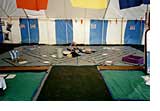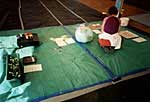
July 2002
Right thing, wrong place
Previous Small Fires


After a sporadic start in the 70s, the festival grew through the 80s and 90s into an established part of the English social calendar. It's a major pop event featuring big-name bands, but also keeps its countercultural roots by sponsoring peace campaigns, social justice and green lifestyles, with a fair helping of New Age spirituality thrown in.
Over the years numbers edged up to 100,000, but with success came crime, overcrowding and social problems. In 2000 the fence was broken down by a mass invasion of 100,000 extra people without tickets. There was no 2001 festival while all involved counted the cost. The local authorities and police demanded radical new security measures if the festival were to happen again.
So this year the silver ribbon of the new improved security fence wound across the countryside like a cross between a Christo artwork and the Berlin Wall. Like the Wall it had a secure zone on either side patrolled by guards in vehicles. Getting through involved multiple checkpoints and turnstiles, but inside was liberty and misrule.
Though not as much misrule as formerly, since the new fence kept out nearly all those whose chief purpose in attending was to thieve or deal drugs. Cannabis, of course, was everywhere, but the police have ceased to bother much. Without the gangs of thieves the atmosphere inside the site was suprisingly mellow. The sun shone and the famous Glastonbury mud didn't materialize. The future of the festival seems secure again.
 I
WENT TO GLASTONBURY to run a labyrinth in the Churches Welcome Marquee,
along with the Youth For Christ Labyrinth tour team Matt and Becky. The
Churches Welcome Marquee is an ecumenical venue which forms the "official"
presence of the church onsite, although there are other Christian presences
– alt.worship group Elemental, the Jesus Army, the Iona community,
the Northumbria community.
I
WENT TO GLASTONBURY to run a labyrinth in the Churches Welcome Marquee,
along with the Youth For Christ Labyrinth tour team Matt and Becky. The
Churches Welcome Marquee is an ecumenical venue which forms the "official"
presence of the church onsite, although there are other Christian presences
– alt.worship group Elemental, the Jesus Army, the Iona community,
the Northumbria community.Although it holds short acts of worship for the staff, the chief purpose of the marquee has been as a sleeping place for festivalgoers who have lost their tents, or who came without them in the first place. This year the churches wanted to do something creative with the marquee during the least busy shift in the afternoon, and so they invited the labyrinth team.
Certainly it seemed like a good idea to us. The labyrinth is very much in tune with the kind of spiritual expressions found at the festival, which include other labyrinths. The hands-off nature of our version made it ideal for an audience of non-Christians just sampling. The therapeutic processes it contains are helpful to people dealing with personal issues even if they have no faith. It emphasises experience; it emphasises doing as much as thinking.
But there were major constraints. The labyrinth had to be set up and taken down each afternoon, since the entire space would be used for sleeping at other times. Theft was likely, so larger items had to be capable of secure storage and smaller items had to be replaceable. This immediately ruled out the use of CD Walkmans and the laptop – we would have to use written meditations and real candles.
Electrical power could not be guaranteed, so TVs were out and background music would have to be battery-operated. The ground would be damp or muddy, people's boots would certainly be muddy or dusty, so the touring cloth could not be used – a new one would have to be made with tarpaulins.
We went in with high hopes and fears. Hopes that the labyrinth would connect with people who would not be reached by conventional presentations of the faith. Fears that half the stuff would be stolen, that drug-addled punters would be freaked by it or scary to deal with – to which end we were working alongside trained counsellors from Frontier Youth Trust.
In the event, neither hopes nor fears were realised. Hardly anyone did the labyrinth, and most of those that did were church people. We were in the official programme, we fly-postered the site, all to no avail. It was utterly dispiriting, after months of effort and anticipation. There was consolation in the compliments of those who did try it, and I had a startling conversation with almost the last person round who had been helped in his search for God.
Maybe it was there for him, who knows. I've always said that I'd rather the right people came – the ones that really need it – than large numbers of "tourists". And for the team personally there was the consolation of free tickets for Glastonbury and free mornings and evenings to sample its delights.
SO WHAT WENT WRONG? How did something so right on paper fail so thoroughly in practice?
The first problem was location. The Churches Welcome Marquee has primarily been a crash space for people with no tents and its placing near the bank and welfare facilities reflects this. Nobody was searching for spirituality at this end of the site – the most frequent daytime request was "Where's the bank?" People were prepared to be tempted by face-painting and banner-making, but the labyrinth required too big a mental change of gear.
We could not control lighting or sound, the two things that create atmosphere and prepare people for what they are entering. We had broad daylight in a white marquee, no way to focus attention and throw unwanted sights into shadow. And as for sound, we were within full earshot of the main stage. Fine for keeping an ear on the performances we could not attend while on shift. But our attempts at ambient music soon had to be given up as a waste of batteries.
Since power supplies could not be guaranteed we had omitted the TVs. The labyrinth looked flat without them. They give height and movement, and supply in daylight something of the atmosphere that can't be achieved by lighting. They give the labyrinth an edge of technology, of contemporary vitality. The original pre-St Paul's Cathedral version didn't have TVs, but it had projections all around. It became apparent that we had lost something strong.
The wind was a nuisance. The marquee caught every gust. The labyrinth tarpaulins flew up into the air if not firmly taped and pegged. Objects blew away. The candles constantly went out, to be endlessly, fruitlessly relit. Yet to have closed up the marquee or put the labyrinth out of the wind would have meant hiding it entirely from passers-by.
Without the voiceover, there were too many words to read. In a more contemplative atmosphere this might not have mattered, but I felt that we were taxing people's patience to give them so many in that setting. They needed more immediacy, more do and go.
And the graphics were wrong. Glastonbury has a definite aesthetic, combining rainbow hippy fluffiness and tough green agit-prop. The labyrinth graphics looked icy, technological in comparison. They seemed to carry a whiff of imperial church, of a controlling mindset, an evangelistic campaign. Strange what a change of context can do. In their original end-of-90s London setting they said contemporary art/nightclub, a conscious contrast to St. Paul's traditional or charismatic jolly. But Glastonbury is no place for that kind of cool. It looks cold.
WHAT WOULD AN appropriate labyrinth for Glastonbury look like? For starters it would be in its own tent, at the other end of the site in the Healing Field, among the therapies and rituals. Being away from the music stages, it would have its own ambient music again. Perhaps the overaching meditation could reappear, as a voiceover or even live. It could be open in the evening and into the night, lit by ornamental lanterns for a rich glow. It could be on cloth rather than tarpaulins, and people could be required to remove their boots.
Or it could be an outdoor straw bale labyrinth like the one last summer in Christchurch, New Zealand – see "Christmas labyrinth" on the Small Fire photo site.
It remains to be seen what the official post-mortem on the experiment will bring up. Experiments don't always work out. But at least we learned a lot about what works and what doesn't. Maybe we can find a more appropriate spiritual intervention for the Churches Welcome Marquee next year.
Click here for the Glastonbury Festival website.
Top | Bio | Columns | SOF Home
© Ship of Fools 2002